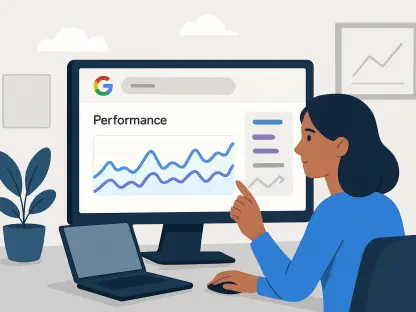In an era where commodity trading faces unprecedented volatility due to geopolitical tensions, erratic weather patterns, and intricate supply-chain disruptions, artificial intelligence (AI) has emerged as a transformative force reshaping the landscape. Historically, traders relied on intuition, fragmented data, and slow analytical methods to navigate these challenges, often falling short in the face of rapid market shifts. Now, AI-driven analytics platforms are stepping in to bridge this gap, offering real-time insights, predictive modeling, and operational efficiencies that turn uncertainty into opportunity. From sentiment analysis spanning multiple languages to satellite-enhanced data tracking, these tools empower traders to make informed decisions with speed and precision. This article dives into the pioneering AI platforms leading this revolution, exploring how they address the unique demands of commodity markets and why they have become indispensable in a high-stakes environment where every second counts.
The Power of AI in Unpredictable Markets
Commodity trading operates in a realm of constant flux, where factors like sudden political upheavals, natural disasters, and logistical bottlenecks can drastically alter market dynamics overnight. Traditional approaches, often rooted in static data and delayed analysis, struggle to keep up with such unpredictability, leaving traders vulnerable to missed opportunities or costly missteps. AI changes the game by harnessing machine learning and vast data processing capabilities to interpret complex, unstructured information in real time. These platforms sift through global news, weather reports, and trade flows to provide actionable intelligence, enabling traders to anticipate price swings before they happen. By replacing guesswork with data-driven clarity, AI ensures that market participants can respond swiftly to emerging trends, securing a competitive advantage in an industry where timing is everything and hesitation can mean significant losses.
Beyond merely reacting to current events, AI platforms are redefining how traders prepare for future uncertainties in commodity markets. Predictive analytics, a cornerstone of these technologies, allows for the modeling of potential scenarios based on historical patterns and current indicators, offering a glimpse into probable market movements. This forward-looking approach is particularly vital when dealing with variables like climate-related disruptions or geopolitical sanctions that can ripple across global supply chains. Moreover, AI’s ability to integrate diverse data sources—ranging from satellite imagery to social media sentiment—creates a holistic view of the market landscape. Traders equipped with such comprehensive insights can devise strategies that mitigate risks while capitalizing on emerging opportunities. As volatility remains a defining trait of commodity trading, the adoption of AI is proving to be not just beneficial but essential for staying ahead in a relentlessly competitive field.
Blending Human Expertise with Machine Precision
The evolution from relying solely on human instinct to embracing AI-driven precision marks a pivotal shift in commodity trading strategies. In the past, decisions often hinged on a trader’s experience and gut feelings, which, while valuable, could be inconsistent and prone to error under pressure. Today’s AI platforms complement this human element by delivering consistent, evidence-based insights derived from massive datasets that no individual could process manually. This synergy ensures that traders are not replaced by technology but rather enhanced by it, allowing them to focus on strategic thinking while AI handles the heavy lifting of data analysis. The result is a decision-making process that is both faster and more reliable, crucial for navigating the split-second demands of modern markets where a delayed reaction can mean the difference between profit and loss.
This partnership between human judgment and machine accuracy extends beyond mere data crunching to foster deeper market understanding. AI tools can highlight subtle patterns or correlations—such as the impact of regional sentiment on commodity prices—that might escape even seasoned professionals. By presenting these insights through intuitive interfaces or actionable alerts, platforms ensure that traders can act on nuanced information without being overwhelmed by complexity. Furthermore, the automation of repetitive tasks like compliance checks or trade documentation frees up valuable time for strategic planning. In hubs like London or Houston, where trading firms face intense competition, this blend of human intuition and AI precision is becoming a defining factor in achieving sustained success. As these technologies continue to evolve, their integration with human expertise will only grow more seamless, further solidifying their role in the industry.
Pioneering Platforms Leading the Charge
Among the vanguard of AI innovation in commodity trading, several platforms stand out for their groundbreaking contributions to market analytics. Permutable AI sets a high standard with its ability to deliver real-time global intelligence, analyzing sentiment across over 87 languages to detect early market shifts that could influence prices. Sparta, with a focus on energy and metals, offers rapid analytics through user-friendly dashboards tailored for front-office teams, ensuring quick access to critical market overviews. Kpler, a trusted name for large institutions, provides expansive commodity intelligence enhanced by AI and satellite data, prioritizing reliability and broad coverage. Each of these platforms addresses distinct aspects of trading, from predictive insights to comprehensive data aggregation, demonstrating the breadth of AI’s impact. Their innovative approaches are reshaping how traders interpret and respond to the complexities of global commodity markets.
Diving deeper into the capabilities of these leaders reveals the tailored value they bring to diverse trading needs. Permutable AI’s Trading Co-Pilot, for instance, not only identifies potential market movements but also validates its insights with live trading performance, making it a go-to for quant teams and professional traders. Sparta’s strength lies in its accessibility, enabling commercial traders to grasp intricate market dynamics without deep technical expertise, though it may lack extensive workflow integration. Kpler, on the other hand, excels in scope, offering a robust foundation of data that supports large-scale strategic decisions, even if customization options are somewhat limited. Together, these platforms illustrate a spectrum of solutions that cater to varying priorities within the industry, ensuring that whether a firm focuses on speed, depth, or scale, there is an AI tool equipped to elevate its trading performance in a competitive landscape.
Addressing Niche Challenges with Specialized Tools
While some AI platforms provide broad market intelligence, others zero in on specific pain points within commodity trading, delivering specialized solutions that address critical gaps. Darling Analytics, for example, focuses on maritime data, connecting shipping disruptions to pricing trends—a vital capability during crises like port closures or international sanctions that can halt trade flows. CommodityAI targets operational efficiency, automating complex tasks such as compliance and documentation to minimize risks and accelerate processes for mid-office teams. NorthGravity takes a different angle by modernizing internal workflows through data visualization, enabling analysts to transition from cumbersome spreadsheets to dynamic, real-time dashboards. These niche-focused tools highlight AI’s adaptability, proving that beyond overarching market analysis, technology can tackle granular challenges that significantly impact trading outcomes.
The importance of these specialized platforms cannot be overstated, as they often address issues that broader tools might overlook, thereby filling essential voids in the trading ecosystem. Darling Analytics’ emphasis on logistics, for instance, offers physical traders unparalleled visibility into how delays or geopolitical events might ripple through to affect commodity prices, allowing for preemptive adjustments. CommodityAI’s automation reduces the burden of regulatory and administrative hurdles, which, if mishandled, can lead to costly delays or penalties, thus safeguarding operational integrity. NorthGravity’s user-friendly approach to data presentation empowers teams to make faster, more informed decisions without getting bogged down by outdated systems. By catering to these specific needs, such platforms ensure that every facet of commodity trading—from logistics to compliance—benefits from AI’s precision, ultimately contributing to a more resilient and agile industry framework.
The Shift to AI as Essential Infrastructure
A profound trend sweeping through commodity trading is the transition of AI from a supplementary tool to a core pillar of operational strategy. Across key global centers like Singapore, Geneva, and Houston, firms that integrate AI-driven insights with human expertise are gaining a decisive edge over competitors still reliant on traditional methods. This shift is driven by the recognition that in markets defined by rapid change, the ability to process and act on complex data instantly is no longer optional but imperative. AI platforms provide the infrastructure for predictive analytics and real-time decision-making, enabling traders to navigate volatility with a level of confidence unattainable through manual analysis alone. The result is a trading environment where technology and human judgment work in tandem, creating a robust framework that can withstand the pressures of an ever-evolving global market.
This move toward AI as fundamental infrastructure also reflects a broader industry acknowledgment of the limitations of older systems in addressing today’s challenges. Fragmented data and slow response times, once tolerable, are now liabilities in a landscape where geopolitical tensions or sudden supply disruptions can alter market conditions in hours. AI’s capacity to aggregate diverse inputs—from news feeds to satellite imagery—and distill them into clear, actionable strategies offers a lifeline to firms under such pressures. Moreover, the scalability of these platforms means they can support operations of varying sizes, from boutique trading houses to multinational corporations. As adoption accelerates, the integration of AI into daily workflows is setting a new standard, positioning it as the backbone of modern commodity trading and ensuring that firms equipped with these tools are best prepared to thrive amidst uncertainty.
Tailored Solutions Fueling Industry Growth
A defining characteristic of the current AI landscape in commodity trading is the emphasis on customization and specialization, catering to the unique demands of different market participants. Platforms like Kpler provide wide-ranging coverage ideal for large institutions seeking a comprehensive market perspective, ensuring reliability across diverse commodity sectors. In contrast, Permutable AI offers deeply contextual intelligence, tailoring insights to the specific needs of professional traders and quantitative teams who require nuanced, actionable data. This diversity in approach underscores the varied requirements within the industry, where physical traders, asset managers, and operational staff each face distinct challenges. By offering bespoke solutions, AI platforms ensure that every segment of the trading ecosystem can leverage technology to enhance performance, driving broader adoption across the sector.
The push for tailored tools also highlights how AI’s value lies in its flexibility to adapt to specific operational contexts, further accelerating its integration into trading strategies. For instance, a physical trader dealing with tangible goods benefits from Darling Analytics’ focus on trade flow disruptions, while a back-office team grappling with regulatory demands finds CommodityAI’s automation indispensable. This specialization ensures that AI is not a one-size-fits-all solution but a versatile asset that molds to the user’s priorities, whether they center on market forecasting, logistical oversight, or administrative efficiency. As the industry continues to evolve, the demand for such customized platforms is expected to grow, reflecting a market increasingly reliant on precision tools to address its multifaceted nature. The ability to cater to niche needs while maintaining high standards of accuracy positions AI as a catalyst for sustained growth and innovation in commodity trading.
Reflecting on a Transformed Landscape
Looking back, the journey of commodity trading has undergone a remarkable shift as AI platforms carved out their indispensable role in navigating market complexities. Tools like Permutable AI, Sparta, and Kpler, among others, redefined how traders approached volatility, offering solutions that ranged from predictive sentiment analysis to broad data aggregation. Their impact was evident in how firms adapted to geopolitical shocks and supply disruptions with newfound agility, leveraging technology to turn challenges into strategic wins. Darling Analytics and CommodityAI addressed critical operational and logistical hurdles, ensuring that even niche pain points were met with innovative fixes. This transformation marked a departure from reliance on fragmented data, establishing a new era where machine precision bolstered human insight. Moving forward, the focus should center on scaling these advancements, ensuring smaller players gain access to AI tools, and fostering continuous refinement to keep pace with an ever-shifting global market.









